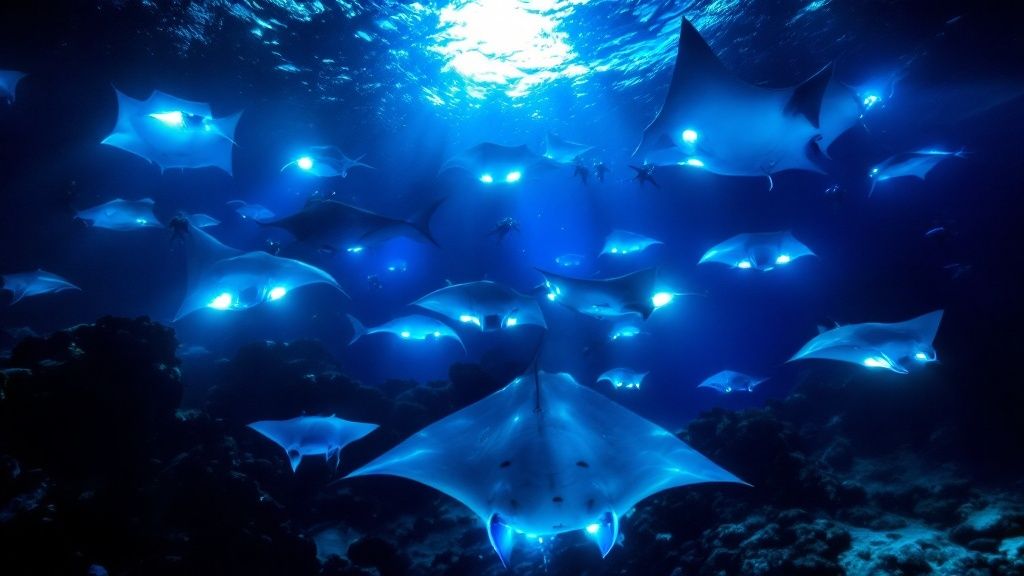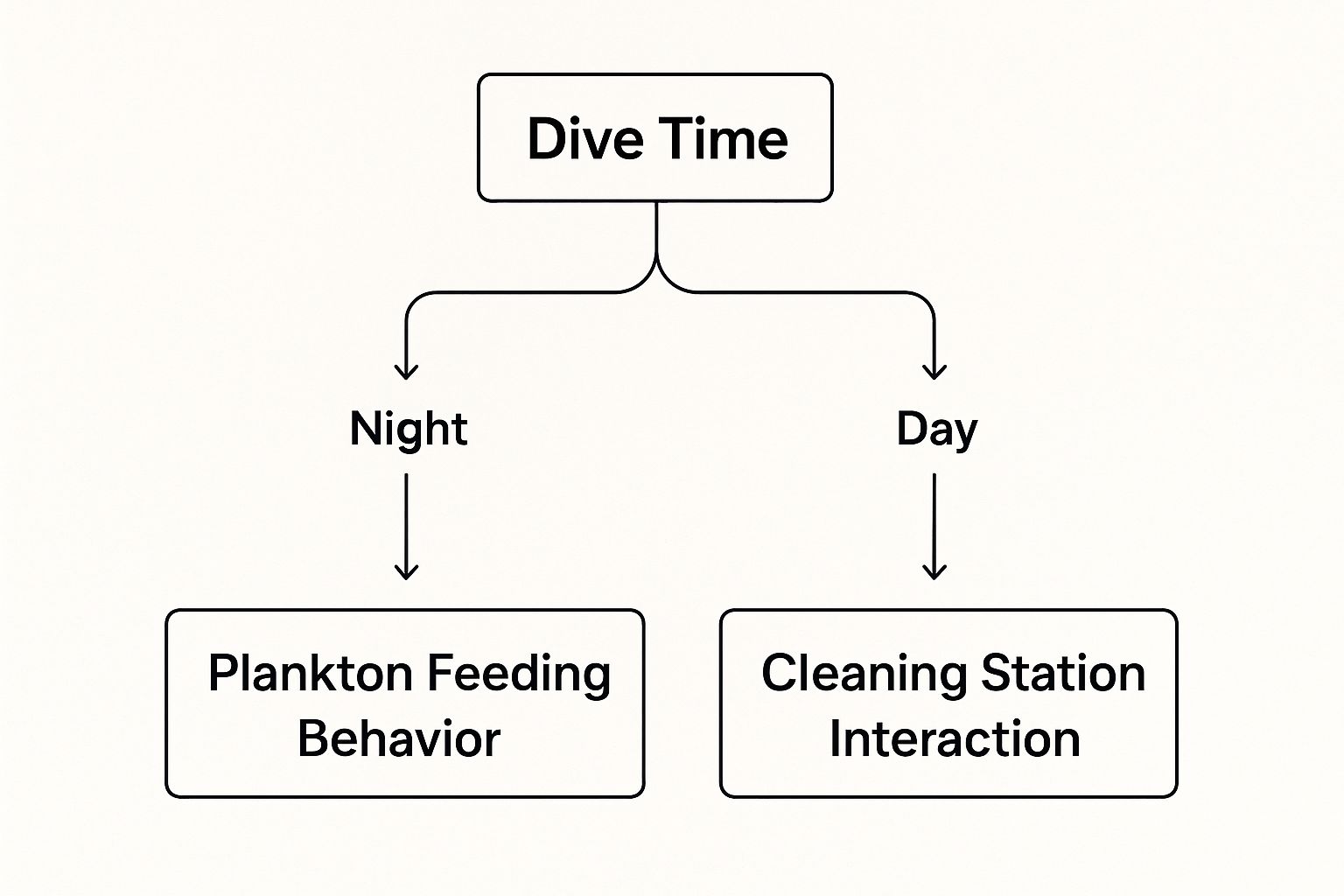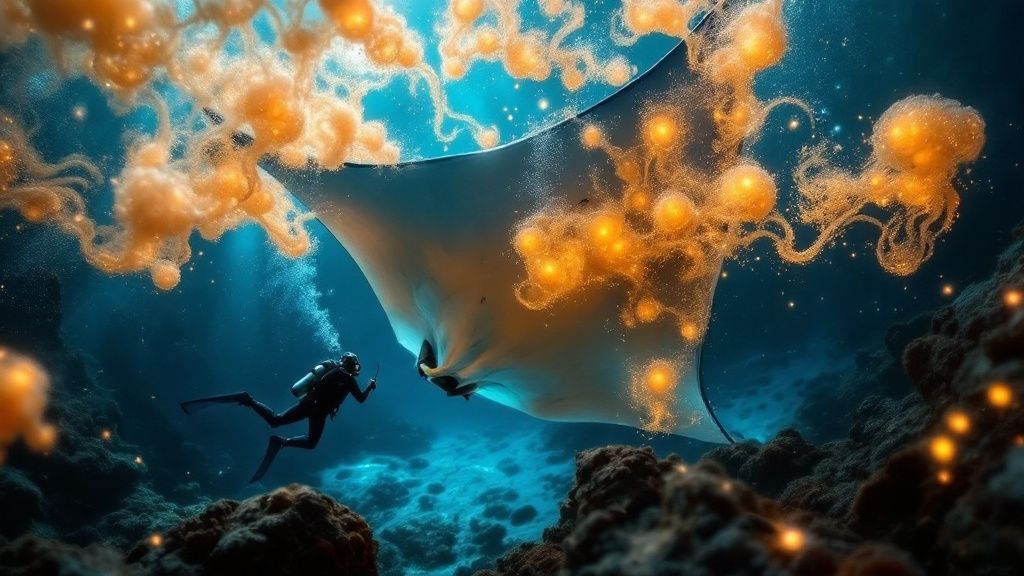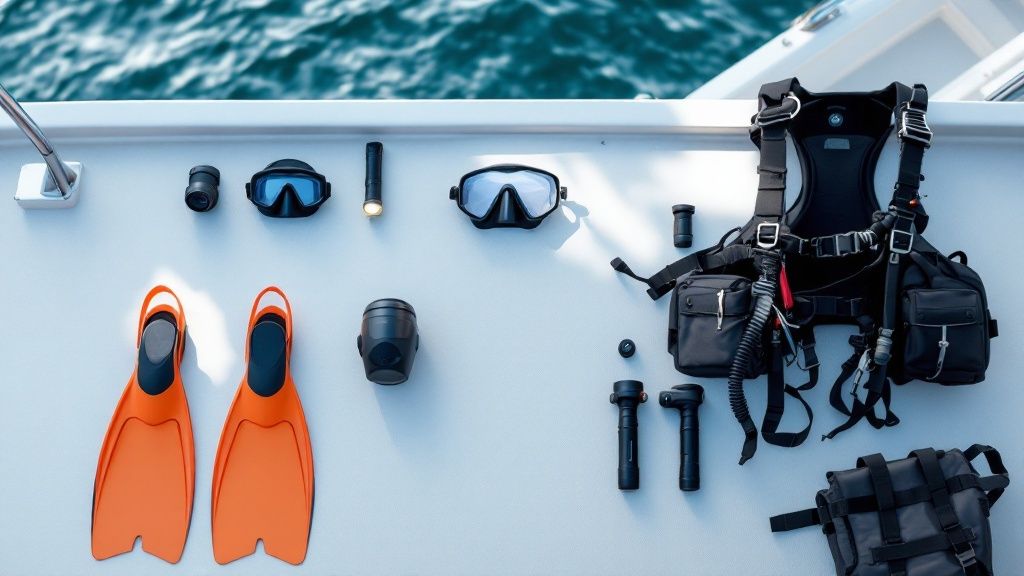Why Kona Dominates The Manta Diving World
Kona isn't just a popular spot for manta ray dives; it's often hailed as the best on the planet. This isn't a coincidence. Kona’s distinctive underwater environment presents a unique blend of factors that attract these gentle giants in impressive numbers.
A key factor is the volcanic topography of the ocean floor. These formations offer shelter for the mantas and create the perfect environment for plankton growth, their primary food source. The nutrient-rich currents that flow along the Kona coast enhance this feeding ground, making it even more appealing.
This combination of volcanic structure and nutrient-rich waters creates what some call a "perfect manta storm".
This abundance of food means mantas consistently return to these feeding areas. This predictable behavior is a key reason why Kona manta dive tours have such high success rates. Sheltered bays like Manta Village act as natural plankton traps, further concentrating the microscopic organisms. This creates an incredible spectacle for divers and snorkelers.
The remarkable water clarity also contributes to the exceptional Kona manta dive experience. The protected coastal waters and generally calm conditions provide fantastic visibility, offering unobstructed views of these graceful creatures. The nighttime setting of these dives adds a truly special dimension. Underwater lights illuminate the mantas against the dark Pacific, creating an unforgettable scene.
Manta diving and snorkeling on the Kona Coast of Hawaii have become renowned, largely due to the area's impressive sighting rates. Operators regularly report an average sighting rate of 85% to 90% throughout most of the year, with some periods even exceeding 95%. For more detailed statistics, check out the Jack's Diving Locker Manta Ray Report. This reliability, coupled with the unique environment, sets Kona apart.
The Unique Kona Night Dive Experience
The distinct features of a Kona manta dive distinguish it from other locations. Unlike places where mantas are usually observed at cleaning stations, Kona offers the unique opportunity to witness their active feeding behavior. This creates a dynamic, engaging, and thrilling experience for divers.
This, coupled with the consistently high sighting rates, has firmly established Kona as a prime manta diving destination. It's a place where the wonder of these gentle giants can be experienced nightly, offering a truly remarkable adventure.
Meet Kona's Incredible Manta Ray Residents
These aren't just fleeting glimpses; Kona offers divers the chance to immerse themselves in a world of familiar manta rays, each with a unique story. The Kona manta ray population has been studied for years, allowing researchers to identify individuals based on their unique ventral (belly) spot patterns. These markings act like fingerprints, offering valuable insights into each manta's life.
Identifying Kona's Gentle Giants
The science behind manta ray identification hinges on these distinct ventral markings. Researchers and conservationists photograph these patterns and catalog them, creating a comprehensive database. This ongoing project allows scientists to track individual movements, understand social interactions, and monitor the overall population's health.
Frequent Flyers and Occasional Guests
Some mantas, like Lefty, are local celebrities, frequently spotted during Kona manta dives. Others are more elusive, making their occasional appearances all the more exciting for dive operators and researchers. This variety makes each dive a unique experience. Tracking data reveals how these graceful giants navigate their underwater world, showcasing their preferred feeding grounds and social dynamics. Statistical tracking of manta ray sightings in Kona reveals both the regularity and individuality of these encounters. Detailed records demonstrate that individual manta rays were identified and tracked during night dives, with some individuals appearing more frequently than others. This provides valuable information on the residency and migration patterns of the local population. Find more detailed statistics here.
You might be interested in: How to Prepare for Your Kona Manta Dive.
Citizen Science: Your Dive Makes a Difference
Even recreational divers can contribute to this important research. By sharing your photos and videos with research organizations, you become a citizen scientist, expanding our knowledge of these remarkable creatures. This transforms your dive into more than just a wildlife encounter; it becomes a meaningful contribution to ongoing conservation research. The Kona manta dive experience is both exhilarating and impactful, with each dive deepening our understanding of these gentle giants and their vital role in the marine ecosystem.

Diving Vs Snorkeling: Which Experience Suits You?
Choosing between a manta dive in Kona and a snorkeling trip depends on the kind of experience you're looking for. Both offer amazing encounters with these gentle giants, but from very different perspectives. Chatting with guides who lead both kinds of tours highlights some key distinctions between these underwater adventures.
Experiencing the Manta Ballet: Up Close or Bird's-Eye View?
Diving takes you down to the ocean floor, right into the middle of the manta's feeding ballet. Imagine being surrounded by these graceful creatures as they perform their captivating movements just above you. Snorkeling, conversely, gives you a bird's-eye view. From the surface, you watch the mantas' aerial acrobatics as they glide and twirl below. This vantage point offers a broader perspective of their interactions.
Duration, Proximity, and Physical Demands
Encounter duration varies greatly between diving and snorkeling. Certified divers can usually stay underwater for longer periods, extending their time with the mantas. Proximity is another factor; diving allows closer encounters as you rest on the ocean floor beneath the feeding mantas. This does, however, involve certain physical demands and requires scuba certification. Snorkeling is less physically demanding, making it perfect for families and those new to water activities. You might be interested in: Manta Ray Snorkeling Kona.
Equipment and Certification
Diving requires specialized equipment and certification, which adds to the cost and preparation time. Snorkeling, on the other hand, requires minimal gear—just a mask, snorkel, and fins—making it a simpler and readily available option. Both diving and snorkeling tours prioritize safety and provide thorough briefings on manta interaction protocols. These protocols protect both you and the mantas, ensuring a sustainable and respectful encounter.
To help you better visualize the differences, take a look at this infographic:

As the infographic shows, night dives offer the chance to observe plankton feeding behavior, while daytime encounters usually focus on cleaning station interactions.
The following table summarizes the key differences between diving and snorkeling with manta rays:
Diving vs Snorkeling: Complete Comparison Guide
Detailed comparison of manta diving and snorkeling experiences including requirements, costs, encounter quality, and suitability for different skill levels
| Experience Type | Requirements | Average Cost | Encounter Duration | Proximity to Mantas | Best For |
|---|---|---|---|---|---|
| Diving | Scuba Certification | $150 – $250 | 30-60 minutes | Very Close | Experienced swimmers, certified divers |
| Snorkeling | Basic swimming skills | $100 – $150 | 15-30 minutes | Moderate | Families, beginners, those who prefer less demanding activity |
Ultimately, the choice between a manta dive in Kona and snorkeling comes down to your comfort level in the water, your budget, and the type of experience you want. Both options offer unforgettable memories, connecting you with these magnificent creatures in their natural environment.
How Kona Became The Global Manta Capital
Kona's reputation as the "Manta Ray Capital of the World" is a compelling example of how natural wonders can capture the human imagination. This unique stretch of Hawaiian coastline draws visitors from around the globe, all hoping to witness the majestic beauty of manta rays. But this popularity isn't a coincidence. It's the result of a specific combination of factors that make Kona the ideal location for manta ray encounters.
The Perfect Manta Storm
Kona’s volcanic slopes create a unique underwater environment. Deep, nutrient-rich currents rise along the coast, bringing with them microscopic plankton, the manta ray's primary food source. This consistent and plentiful food supply attracts mantas to predictable areas night after night. The volcanic formations also offer shelter, further cementing Kona's status as a manta ray haven. This predictable feeding behavior allows Kona manta ray dive tour operators to boast remarkably high success rates, exceeding even other well-known manta ray destinations such as Indonesia, Ecuador, and the Maldives.
Nighttime Spectacle
The Kona manta ray experience is amplified by its unique nighttime setting. Divers and snorkelers gather on the ocean floor or float on the surface using specialized lights. These lights attract plankton, creating an illuminated feast for the mantas. This breathtaking display unfolds against the dark backdrop of the Pacific Ocean, providing a truly unforgettable view of these graceful giants as they glide and twirl through the illuminated water. Curious about the best time to visit? Check out this article: What Is The Best Time of Year To See Manta Rays in Kona?.
Accessibility and Consistency: The Kona Advantage
Kona’s location on the Big Island of Hawaii makes it easily accessible for travelers, both domestic and international. This convenient access, combined with the consistent presence of manta rays, solidifies Kona’s position as a premier destination. The popularity of manta ray snorkeling and diving has soared, with approximately 80,000 participants annually. This number highlights the global appeal of these encounters, making Kona the most visited manta ray destination worldwide. For more detailed statistics, click here. The combination of accessibility, reliable sightings, and the sheer spectacle of the experience has made Kona a leading example of sustainable marine wildlife tourism.

Exploring Kona's Premier Manta Ray Dive Sites
Not all manta ray dive sites in Kona are the same. Understanding the unique characteristics of each location can transform a simple dive into an extraordinary adventure. This section explores Kona's most renowned manta ray dive sites, from the famous Manta Village to the awe-inspiring Manta Heaven.
Manta Village: The Original Kona Manta Dive Site
Manta Village, located off the coast of the Sheraton Keauhou Bay Resort & Spa, truly lives up to its name. This site boasts an impressive sighting rate, often exceeding 90%. The shallow, protected bay creates a natural feeding ground, trapping plankton and attracting mantas in abundance. The calm, shallow waters make this location ideal for both snorkelers and divers. Veteran dive masters frequently recommend Manta Village for those new to manta ray diving in Kona because of its easy access and consistent manta ray activity.
Manta Heaven: A Larger-Than-Life Encounter
Just as the name suggests, Manta Heaven, situated off the Kona International Airport, offers an unparalleled experience. Although the sighting rate might be slightly lower than Manta Village, the sheer number of mantas seen on each dive is often much higher. Imagine witnessing a mesmerizing ballet of multiple manta rays gracefully gliding through the illuminated water. Manta Heaven is somewhat deeper than Manta Village, making it a particularly immersive dive for certified divers.
The Kohala Coast: A Secluded Manta Dive Kona Gem
North of Kona, near the Kohala Coast Resorts and Kawaihae Harbor, you’ll find a less-visited manta ray dive site. While manta sightings might be less predictable compared to Manta Village or Manta Heaven, the Kohala Coast presents a more secluded and intimate experience. For divers seeking a quieter encounter with fewer crowds, this site offers a unique opportunity to witness these gentle giants in a truly tranquil environment.
To help you choose your ideal dive location, we've compiled a table outlining the key features of each site:
To help you choose your ideal dive location, we've compiled a table summarizing key information about Kona's top manta ray sites:
Kona's Premier Manta Ray Dive Sites
| Site Name | Depth Range (ft) | Typical Conditions | Average Mantas Seen | Best Times | Unique Features |
|---|---|---|---|---|---|
| Manta Village | 10-30 | Calm, shallow | 5-10 | Sunset-Night | Easy access, high sightings |
| Manta Heaven | 30-40 | Deeper, open water | 8-15 | Sunset-Night | Potential for larger groups |
| Kohala Coast | 20-40 | Variable | 2-5 | Sunset-Night | Secluded, tranquil setting |
This table provides a quick overview of the depth, conditions, and typical manta activity at each site, along with the recommended times for the best viewing experience. Each location offers something unique.
Choosing Your Ideal Manta Dive Kona Location
The best manta dive site depends on your individual experience and what you are looking for in a dive. Factors such as boat ride duration, how to best position yourself for optimal viewing, and understanding how environmental conditions impact site selection on a given night all play a role. Experienced divers might prefer the deeper waters of Manta Heaven, while newer divers or those susceptible to seasickness may appreciate the sheltered bay of Manta Village. Those seeking a quieter experience might find the Kohala Coast more to their liking. More information about manta ray night dives can be found here.
No matter which location you choose, a manta ray dive in Kona promises an unforgettable experience. Always remember to follow your dive master’s guidance for safe and respectful interactions with these majestic creatures. Each site provides a unique perspective, enhancing your overall Kona manta ray dive adventure. Whether it’s the consistent sightings at Manta Village, the possibility of larger groups at Manta Heaven, or the peaceful atmosphere of the Kohala Coast, Kona offers diverse opportunities to connect with manta rays in their natural habitat. Understanding the nuances of each site will ensure you're well-prepared to witness these magnificent creatures in all their glory.
Planning Your Ultimate Manta Encounter
Turning your manta ray dreams into a reality begins with planning. Smart preparation maximizes every aspect of your Kona manta dive adventure. This involves understanding the local environment and picking a reputable tour operator to guarantee a safe and amazing experience.
Timing Is Everything: Seasonal Patterns and Moon Phases
Kona's manta rays are present year-round, but some seasons offer more predictable conditions. From April to October, the waters are generally calmer and visibility is better. This means more comfortable dives and clearer underwater views. Also, think about the moon phase. Less moonlight enhances the visibility of the plankton that attracts the mantas, creating a more dramatic feeding display on night dives.
Choosing the Right Operator: Safety and Expertise
A responsible tour operator is essential. Check out our guide on Why You Should Go on a Manta Ray Dive in Kona. Seek operators dedicated to sustainable practices and manta ray conservation, such as Kona Honu Divers. Review testimonials and verify certifications to confirm their experience and commitment to safety. A good operator will explain manta interaction protocols, ensuring a respectful encounter for both divers and the mantas.
Preparing for Your Underwater Adventure: Physical and Mental Readiness
Getting ready for a manta dive also means personal preparation. Think about your dietary choices, especially before night dives, and stay well-hydrated. If you’re susceptible to seasickness, consult your doctor about preventative options. Managing pre-dive anxiety is important too. Deep breathing and talking to your dive guide can help calm any nerves.
Setting Realistic Expectations: Embracing the Unpredictable
While Kona manta dives have high success rates, remember that wildlife encounters are unpredictable. Realistic expectations can make your experience better. Even a short glimpse of these graceful creatures is inspiring. Focusing on the entire experience, including the nighttime ocean setting, can make any encounter memorable, regardless of manta ray activity.

Booking Strategies and Backup Plans
Finally, book your dive in advance, especially during popular times. Have backup plans for weather changes. Flexible dates and other activities can lessen disappointment if your dive is rescheduled. With good planning and an adventurous spirit, your Kona manta dive will be unforgettable.
Key Takeaways
Ready for an incredible manta ray dive in Kona? Here's what you need to know to make your trip truly memorable.
Booking Your Dream Dive
-
Book Early: Kona manta ray dives are incredibly popular, especially during peak season (April-October). Booking in advance secures your spot and avoids disappointment.
-
Choose Wisely: Do your research and select a reputable operator, like Kona Honu Divers, committed to sustainable practices. Consider group size, experience level, and what amenities are included.
-
Have a Backup Plan: Kona weather can be unpredictable. Flexibility with your dates is key. Have alternative activities in mind just in case your dive needs to be rescheduled.
Preparing For Your Manta Encounter
-
Gear Up: Pack a wetsuit (3mm or 5mm, depending on the season), reef-safe sunscreen, and an underwater camera with good low-light capabilities. If you're prone to seasickness, pack appropriate remedies.
-
Manta Manners: These gentle giants deserve our respect. Never touch a manta ray, avoid sudden movements, and listen carefully to your guide's instructions. Kona manta ray dive operators have high success rates of 80-90%, with some locations like Manta Village reporting even higher. This predictability makes Kona a special place for manta encounters compared to other global hotspots. Around 80,000 visitors experience these dives annually, a testament to Kona's popularity.
-
Manage Expectations: While Kona offers amazing manta ray viewing opportunities, wildlife sightings are never guaranteed. Even a quick glimpse of these magnificent creatures is a worthwhile experience.
Beyond The Dive
-
Maximize Your Kona Trip: Explore the island's many offerings! Visit Volcanoes National Park, tour coffee plantations, or relax on Kona's stunning beaches.
-
Support Local Conservation: Choose operators like Kona Honu Divers that contribute to manta ray research and preservation. Your choice makes a difference.
Ready to experience the magic? Book your unforgettable manta ray dive with Kona Honu Divers today!
